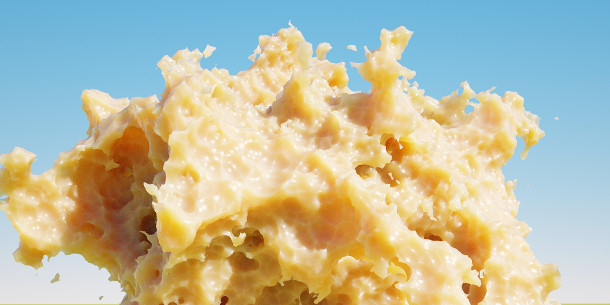Otoy releases OctaneRender 3.0

Otoy’s upcoming OctaneRender 3 will introduce support for volumetrics to the GPU-based renderer. As well as clouds and smoke, the new volumetric primitive enables users to create a range of organic-looking materials.
Originally posted on 19 March 2015. Scroll down for news of the commercial release.
Otoy has announced OctaneRender 3, a major update to the GPU-based renderer that will add a range of key technologies for integrating Octane into VFX pipelines – and will, Otoy claims, ready it for use in virtual reality.
The announcement was made at Nvidia’s GPU Technology Conference.
Volumetric rendering for clouds – and sponges and jellies, too
The headline feature in OctaneRender 3 is volumetric rendering, including support for the OpenVDB file format.
As well as enabling the usual cloud, smoke and fog effects, OctaneRender 3 will include a “unique native primitive type for micro-surface displacement volumes”, intended to create “natural and organic materials”.
The demo images, such as the one at the top of the story, show unusual sponge- and jelly-like objects.
Support for key open-source VFX technologies
Other VFX-friendly features in OctaneRender 3 include support for key technologies like the Imageworks-developed Open Shading Language, the Disney-developed Ptex texture format, and Autodesk’s FBX format.
Updated 24 May 2016: FBX and Ptex support have been dropped from the final 3.0 release.
Integration with compositing tools has also been strengthened: deep pixel rendering will be supported, and the Nuke plugin will support live linking between the two applications – new since the early betas.
The release will also include a built-in plugin that will “properly handle multi-layer EXR files and support live deep pixel layer compositing within Photoshop”.
In addition, it will be possible to author your own custom plugins in C as well as the Lua scripting language.
Improved performance, OpenCL support, GPU-powered baking
Two other big changes beneath the hood are the removal of geometry limits – Octane can now render “infinite” meshes – and support for OpenCL, meaning that the software will run on AMD GPUs and Intel CPUs.
Updated 24 May 2016: Rather than support OpenCL, Otoy has now elected to cross-compile its CUDA code to run on non-Nvidia GPUs.
The firm has showed a demo of OctaneRender running on an AMD card, but AMD support isn’t available out of the box with OctaneRender 3: something Otoy ascribes to “driver issues that need to be fixed by the vendor”.
At time of posting, there’s no official estimate of when this will happen.
And artists working outside VFX aren’t entirely left out: games artists will get unbiased GPU texture baking of global illumination, spherical harmonics and 8D light fields in the upcoming Unreal Engine 4 and Unity plugins.
ORBX: gateway to VR?
But perhaps the most unusual – and the most potentially disruptive – new feature in OctaneRender 3 is its ORBX media format, which Otoy believes will become a “critical authoring format for VR and AR applications”.
An interchange format for rendered output “beyond EXR”, ORBX supports movies; audio; spectral render, light field and baked FBX caching; compositing and deep pixel metadata; and navigable scene controls.
The format, which works in JavaScript and Lua, will be made available open source via GitHub when OctaneRender 3 ships.
Updated 24 May 2016: OctaneRender 3.0 is now officially shipping. The software is available for 64-bit Windows, Linux and Mac OS X. The price of a new licence rises from €299 (around $340) to $399.
Since we originally posted this story in March 2015, several features have been dropped from the 3.0 release. We’ve updated the text above, while the links below show the final feature list.
As well as the core renderer, 18 integration plugins for DCC and CAD packages are available commercially, but don’t expect them all to work with OctaneRender 3.0 out of the box: at the time of posting, they were still being updated to support the new release, which Otoy says “may take some time”.
Read more about the new features in OctaneRender 3 on Otoy’s website
